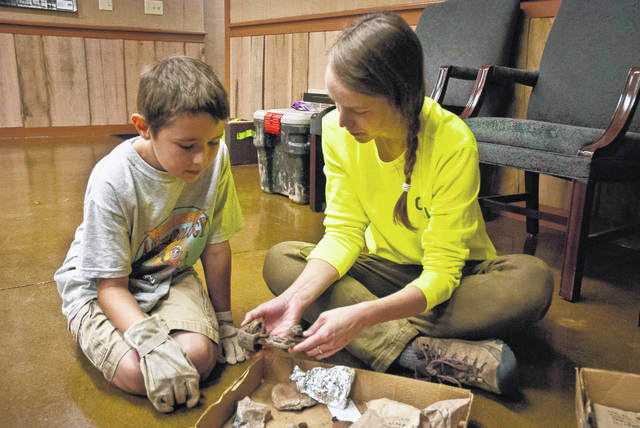

Since the beginning of the week, 14 student archaeologists have been engaged in digging holes on the property of the Meeker Homestead, 2690 Stratford Road, Delaware, as a fun way to study Delaware County’s past.
Donna Meyer, executive director, said she majored in archaeology in college and that the dig was something she has always wanted to do.
“I really wanted to do archaeology but there were no jobs available, so I started working for the non-profit sector,” she said. “I’ve been the director here for almost four years and I always want to do this kind of project because I think this is really hands-on. There are secrets in the soil and we need to teach these kids how to find them. “
Meyer said the Delaware County Historical Society (DCHS) received a grant from an anonymous donor last year. She said the grant allowed the Society to employ Ohio Valley Archaeology Inc. (OVAI) to use ground-penetrating radar and magnetometry (measuring and mapping patterns of magnetism in the soil) to study of the grounds of the property.
“The studies were used to detect anything metal or anomalies in the soil indicating there might possibly be something (buried) there. “They scanned the front and the back with what kind of looks like a big lawnmower,” she said. “We were really looking to find the original Meeker barn.”
According to Meyer, the barn that stands on the property today is the “second-generation barn.”
“It was built in 1848, but Forest Meeker settled here in 1811,” she said. “He had animals so he would have built a barn before he built a house. We didn’t find it because with the study we would have been able to determine if there was something in the soil.”
Meyer said that the students, 8-14 years old, were divided into three groups and assigned a place to dig where the ground-penetrating radar and magnetometry studies showed signs of anomalies in the soil.
“They have been out here digging since Monday,” she said. “OVAI is really showing them a lot of things like how to dig and to sift to find things in the dirt.”
However, as for the 50-centimeter holes, Meyer said that OVAI assured her that once the dig is finished on Friday, the excavated dirt would be returned to the holes from where it came.
Jessica Clark, OVAI archaeologist, and a principal investigator, said the Columbus-based company is a cultural resource management firm that does a wide variety of things where teaching was only one component of everything.
“We do a lot of what we call cultural resource management that involves working for public and private clients,” she said. “We do a lot of federal compliance archaeology that helps our clients comply with their federal obligations to make sure that cultural resources are assessed and protected as development moves forward.”
Clark said OVAI always looks forward to opportunities to share archaeological moments like a shovel dig with “excited younger people.”
Each time a piece is discovered the students took depth measurements, drew a detailed map, and placed the artifacts into a brown paper bag. Many of the items that they discovered were pieces of brick, glass, and formed metal that was probably once a tool.
Lincoln Beachy said he found digging in the dirt to find artifacts to be “really fun.”
“We found a lot of brick fragments and on previous levels, we found glass, ceramics and some square nails,” he said. “The glass looks like a piece of a jar or something rounded.”
Meyers said they think it is brick from the old smokehouse that has been torn down.
Ben Feller said he likes the project but found all the digging to be “exhausting.”
However, Sebastian Kauffman said later in life he wanted to become an archaeologist, move to Egypt and work on digs there.
Working at a sifter that stood on legs about 4-feet high, Amanda Comstock said she really wanted to do the dig when she was presented with the idea.
“I’ve learned to find artifacts and different types of ceramics like redware, whiteware, and Creamware,” she said. “And a prehistoric arrowhead.”
Meyer said that OVAI is going to do a report on the artifacts found at the site and that the DCHS will pick a time, invite the students and parents, and do a PowerPoint presentation based on OVAI report.



